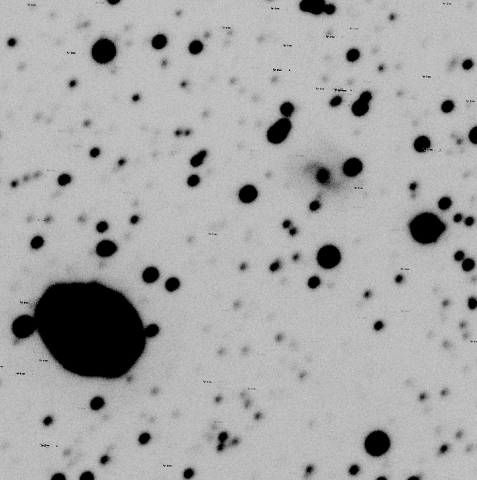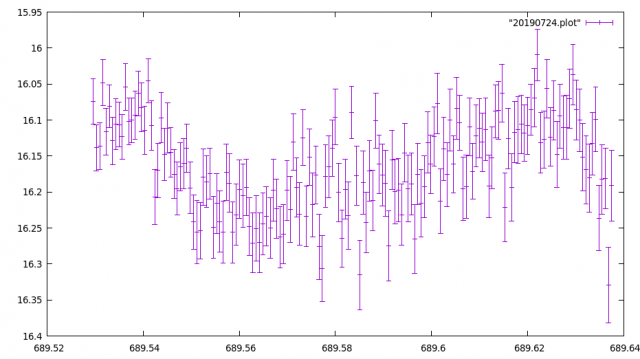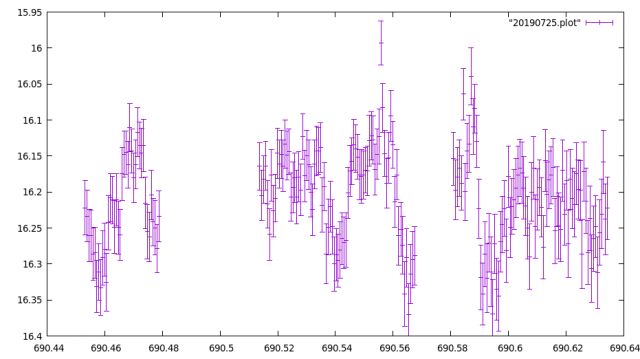Forum Replies Created
-
AuthorPosts
-
28 August 2019 at 5:05 pm in reply to: Automated surveys and Comets in Milky Way Starfields. #581320
 Dr Paul LeylandParticipant
Dr Paul LeylandParticipantGood question.
Given that many new facilities are on alt-az mounts …
 Dr Paul LeylandParticipant
Dr Paul LeylandParticipantLooks like shadows cast by some objects (clouds near or below apparent horizon perhaps) on the regular forward-scattered sunlight.
 Dr Paul LeylandParticipant
Dr Paul LeylandParticipantThanks. I may well add it to my program later this year once the imaging problems are worked out. Just found https://arxiv.org/abs/1607.08082 which contains a finder chart and a comparison sequence. I will investigate further.
Do you have any recent literature references to hand?
 Dr Paul LeylandParticipant
Dr Paul LeylandParticipantA round tuit arrived today so I uploaded the two nights of THL data to the CalTech periodogram engine. The results are (to me at least) are interesting. Several methods of period searching were used. All gave peaks at close to 0.0281 days and twice that (0.0562 days). The former is 40.3 minutes, which seems rather short. Twice that, 80.6 minutes, is absolutely typical of CV binaries. Perhaps a little on the short side but not exceptionally so — that of WZ Sge is 0.05671 days. The 40.3m light curve shows only a single dip. The other, of course, shows two which if real suggests eclipses of two stars of fairly similar magnitudes.
Another period which comes up strongly is at 0.08 days — 2 hours or so — or perhaps twice that. This is doubtless the 0.1 variation mentioned in the earlier post.
Only two nights and 359 measurements were analysed. Time for me to download more of the BAA-VSS database and see whether the patterns hold up.
 Dr Paul LeylandParticipant
Dr Paul LeylandParticipantI don’t know of any reported variability of Sk -69 202. I’d be mildly surprised if it wasn’t variable.
A good number of LBVs are accessible to amateur observation. AE And and AF And are on my observing program. Eventually I’ll take a look at others in M31 and make start on those in M33. It’s a shame that the LMC and SMC never rise here.
Your mission, Robin, should you choose to accept it, is to take spectra of AE & AF And. This post will self-destruct in five seconds.
😉
 Dr Paul LeylandParticipant
Dr Paul LeylandParticipantAre you sure that the same star was involved?
My understanding, which may well be wrong, is that the objects concerned were very close together on the sky but it’s far from certain that they were identically the same object.
A better example, perhaps, might by SN 1987A, aka Sanduleak -69 202. There is absolutely no doubt there that the SN precursor had been studied by Sanduleak.
 Dr Paul LeylandParticipant
Dr Paul LeylandParticipant“It was a test of how deep I could go with my first astro camera,”
I’ll take that as a challenge. The old camera could reach 22.0 Gaia -g, a good approximation to the SBIG’s unfiltered spectral response, with a reasonable exposure time. When all the niggles have been worked out I’ll try for the H-II regions in IC 1296 and a better view of the more distant galaxy.
 Dr Paul LeylandParticipant
Dr Paul LeylandParticipantYou are almost certainly correct. SWarp was used to co-add a number of subs. As the intention was to acquire an image, any image, no biases, darks, flats, bad pixel masks or anything else were used. The filter wheel was playing up and I can no longer remember what, if any, filter was used. The FITS headers claim no filter, which seems plausible, but I wouldn’t swear to it.
 Dr Paul LeylandParticipant
Dr Paul LeylandParticipantThe SBIG died unpleasantly and after some deliberation I purchased a Trius 814 from Starlight Xpress. There were many many teething problems but first light came last night. Images are still not as pretty as I would like but one, of a beautiful face-on barred spiral in Lyra called IC 1296, appears below. The bright nucleus is over-exposed to bring out the detail in the spiral arms. I’m certain much better images can be obtained after more tweaking the configuration of various bits of hardware. In particular, I don’t understand what generates the dotty artefacts visible in the image, and there’s some trailing, possibly because the OAG and AO units are not working properly (or at all).

According to a local installation of astrometry.net the plate scale is 0.292 as/pix which matches the theoretical resolution nicely and at 2×2 binning (0.584 as/pix) a typical 2-3as seeing disk is 4-5 pixels across. Just what I wanted.
(OK, I confess to being mischievous. The large blobby thing at the lower-left is M57. I happen to think the 15th magnitude galaxy is prettier.)
Added in edit: I just spotted 2MASX J18530959+3305385, the faint fuzzy just to the left of the top-most star on the right edge of the image. According to SIMBAD it is 10as across and rather red; I can’t find a V magnitude but guess it’s around 16-17.
 Dr Paul LeylandParticipant
Dr Paul LeylandParticipant

Both nights show fluctuations of about 0.15 magnitudes in V with a (eyeballed) period of about 0.1 days. More and, I hope, better analysis to come.
(Edited to give the y-axis its conventional direction)
 Dr Paul LeylandParticipant
Dr Paul LeylandParticipantYesterday I processed two nights’ data taken by Kevin Hills, 160 and 199 images respectively. They would be in the database by now but a vicious migraine wiped me out for all of today. Still very fragile now.
I’ll have another look for short periodicity.
 Dr Paul LeylandParticipant
Dr Paul LeylandParticipant” but more especially the bulk density of Bennu is only 1.26+/-0.07 g/cc. So as there are a lot of voids between the boulders, their density will be close to 1.0 g/cc on average.”
I’m confused. You appear to say that the bulk density (1.26) is greater than the boulder density (average 1.0). How can this be? Is the latter figure a typo for 2.0, say?
 Dr Paul LeylandParticipant
Dr Paul LeylandParticipantHave you downloaded the complete GCVS? If so a preliminary selection based on a minimum Dec, a plausible range of RA and a type of EA, EB, … will give you an initial range of candidates.
What do you consider high-cadence? Minutes, seconds or milliseconds?
My 0.4m telescope (located only about 100km from El Teide) could manage a very few millimags precision (unfiltered CCD, so approximately Gaia G band) down to mag 11.5 with a cadence of around a minute as demonstrated with an observation of an exoplanet transit.
In fact, why don’t you try for an exoplanet transit? Not only do you get your differential timing data, you also add to our knowedge of exoplanets. The minimum may be wide but the ingress and egress events are short-lived and it’s generally possible to observe both in a single session.
Would you like me to join in perhaps, weather permitting? It’s been unusually cloudy in these parts of late. I also need to get the new camera commissioned first but I hope that doesn’t take too long.
 Dr Paul LeylandParticipant
Dr Paul LeylandParticipantI thought it was just me until your post. It appears under Chromium, the free version of Chrome, on this Ubuntu system. Not yetchecked with Firefux under Ubuntu.
I hope long time Usenet afficionados here recognize the Subject line It’s quite a while since I last saw it on a net posting but these days nostalgia doesn’t seem like it used to be. Such cultural references should be preserved IMHO.
 Dr Paul LeylandParticipant
Dr Paul LeylandParticipantThanks for the clarification. I’d mis-remembered the details.
 Dr Paul LeylandParticipant
Dr Paul LeylandParticipantIndeed, this is a worthy addition to the terms of the challenge.
 Dr Paul LeylandParticipant
Dr Paul LeylandParticipantSold the SBIG-8 and CFW10. Thanks Denis!
Anyone want a AO7?
 Dr Paul LeylandParticipant
Dr Paul LeylandParticipantThat is seriously bad news from my point of view. Can you point me to sources of information about the incompatibility of these two components please?
If it’s seriously the case it will be much easier for me to continue with Win7 and insert an old PC configured as a nailed-down firewall between the observatory and the interweb thingy.
Added in edit: just found https://www.cloudynights.com/topic/515833-windows-10-and-maxim/ — opinions seem mixed. Some had serious troubles, others had none.
 Dr Paul LeylandParticipant
Dr Paul LeylandParticipantThanks Eric.
In my case I’ve a bunch of additional cards in the PC, serial ports mostly, which may not work in a new system so I’m averse to swapping the hardware given that it appears to be working well.
 Dr Paul LeylandParticipant
Dr Paul LeylandParticipantI wasn’t sure whether to revive this thread or start a new one but then plumped for this. Background: today is the re-awakening for my W7-Ultimate observatory controller. Windoze Update just brung over 66 updates (it’s been asleep since April 2 after all) and a dire warning that security updates will not be available after January 14 2020. Actually, Enero 14 2020 because it’s a Spanish install but we know what it means.
The material posted above indicates that W10 home should work fine but it isn’t clear whether that is through a fresh install or after upgrading from (presumably) W7. Can anyone set my mind at rest please? The hassle of re-installing everything anew is daunting so I’d much prefer to upgrade.
Thanks, Paul
-
AuthorPosts
